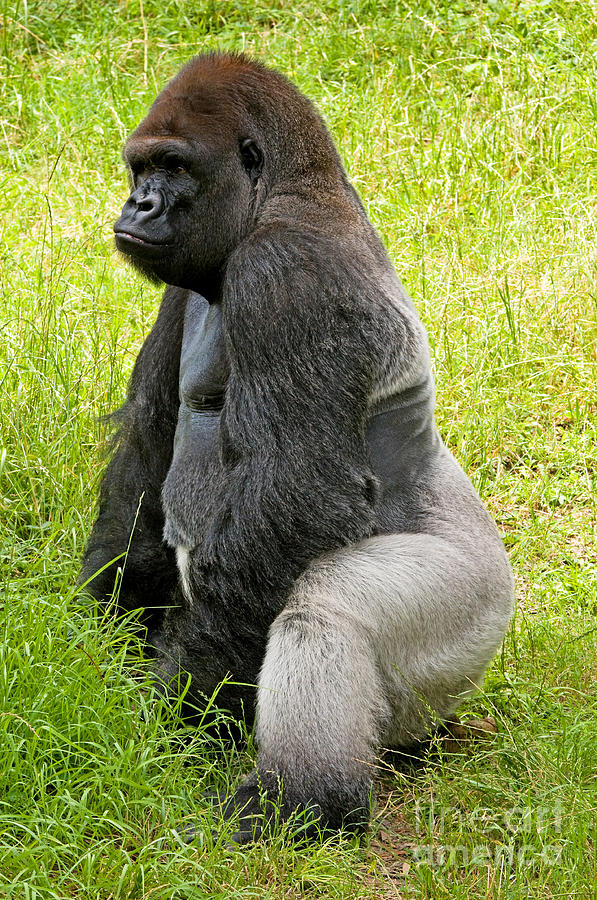

Gorillas are herbivores and therefore only eat fruit and leaves. They are breast fed for the first three years of their life, but begin to eat vegetation at around six months. Baby gorillas learn to crawl at around two months, can ride on their mothers backs at seven months and walk at nine months. Gestation takes approximately 8.5 months and a single infant is produced.

Mating activity is usually initiated by the female and occurs all year round. However, males mature later and don’t usually reproduce before 15 years old. Mothers are very protective of their young and maintain a strong bond with them through close physical contact the dominant silverback will also interact with young, though primary care is left to the mother.įemale gorillas in the wild become sexually mature at around 10 years old. Infanticide (the killing of young) takes place on occasions when a dominant silverback dies and a new male replaces him, killing all his offspring. They live in polygamous groups, meaning the dominant male mates with all the females and mating occurs when the female is mid way through her cycle. Gorillas have very slow rates of reproduction and high rates of infant mortality, as many as 40% do not survive after birth. Within groups lower ranking members usually groom high ranking members and adult females do not groom each other.

They touch each others face and hands for reassurance and groom each other regularly. Tactile communication is very important for gorillas as it helps them to create and maintain strong social bonds. This is known as the ‘fear smell’ as it can warn other gorilla of impending danger and is a signal of excitement and aggression. The silverback releases chemicals called pheromones from glands in his armpits, which have a strong odour. This can be used as an attempt to lure females away from groups. Pursed lips and raised eyebrows, used by infants when left alone.Ī strutting walk and bristled hair occasionally glancing at the female. Open mouth grimace with raised eyebrows and tilted head.
Western lowland gorilla intelligence series#
Gorillas, like humans use a series of facial expressions and body movements to convey messages and emotions.Ĭhest beating, staring with pursed lips and a tensed mouth with teeth bared. Unlike humans they have large Laryngeal sacs within their vocal chamber which can be filled with up to seven litres of air, and used to increase the volume of their calls. Gorillas produce over 20 recognized sounds, each with unique meaning. They usually travel alone or with a group of other males until they can attract a mate. When they reach sexual maturity at the age of ten they leave their family groups to join another or form their own and find a mate. They support the leader and help them forage. Younger male gorillas are called blackbacks because they have not yet developed silver hair on their back like mature males, though all males will not necessarily develop a silver back. As part of a gorilla language project, Koko a western lowland gorilla has been taught American Sign Language and has mastered 1,000 words. Some gorillas in captivity have been taught to communicate with humans. On this morning, when the boot falls to the ground for a moment, a suspicious chipmunk comes a bit too close, causing the gorilla to snatch up her boot in a hurry before ol’ Chippy can steal it.Introduction, Species, and Habitat Evolution, Social Structure, and Activitiesĭiseases and Threats Conservation and Saving Gorillas Sometimes she even manages to get three boots on her frame. It’s a security blanket for the 216-pound gal who loves onions. In the meantime, 41-year-old Juju has thrown an old boot on her broad back as she searches for delicious food to consume.

“She marches to the beat of her own drum, which we love about her.” “She’s kind of the oddball of the group,” Tuchman said. It’s normal behavior for her, as she was bottom-ranking in the troop for many years, and had to learn to be scrappier than the other girls. There’s 29-year-old Kwisha, who slowly gathers and stores away produce in her arms. “They’re not social groomers like other primates. “They all have their personal-space bubble,” Tuchman said. And they kind of feed off that energy from him.”Īs keepers rain down veggies, including lettuce, kale, corn, bell peppers, tomatoes and onions, into their forested outdoor living quarters, the herbivorous apes slowly begin to dine. He’s sweet and gentle with her,” said Primate World Keeper Amy Tuchman. Abby Jordan interacts with Kwisha, a Western lowland gorilla, after the gorilla gathered up her vegetarian morning feast at Cheyenne Mountain Zoo.


 0 kommentar(er)
0 kommentar(er)
